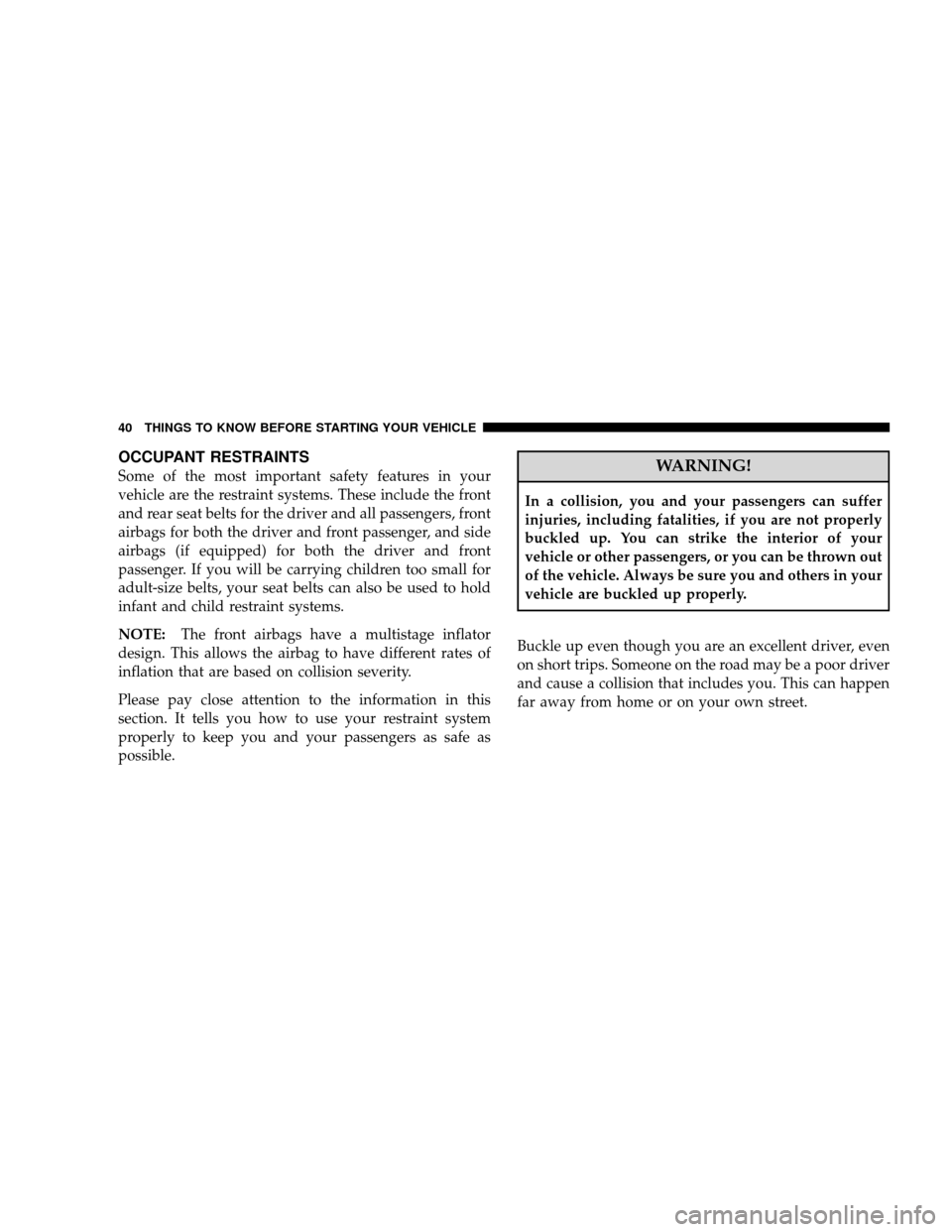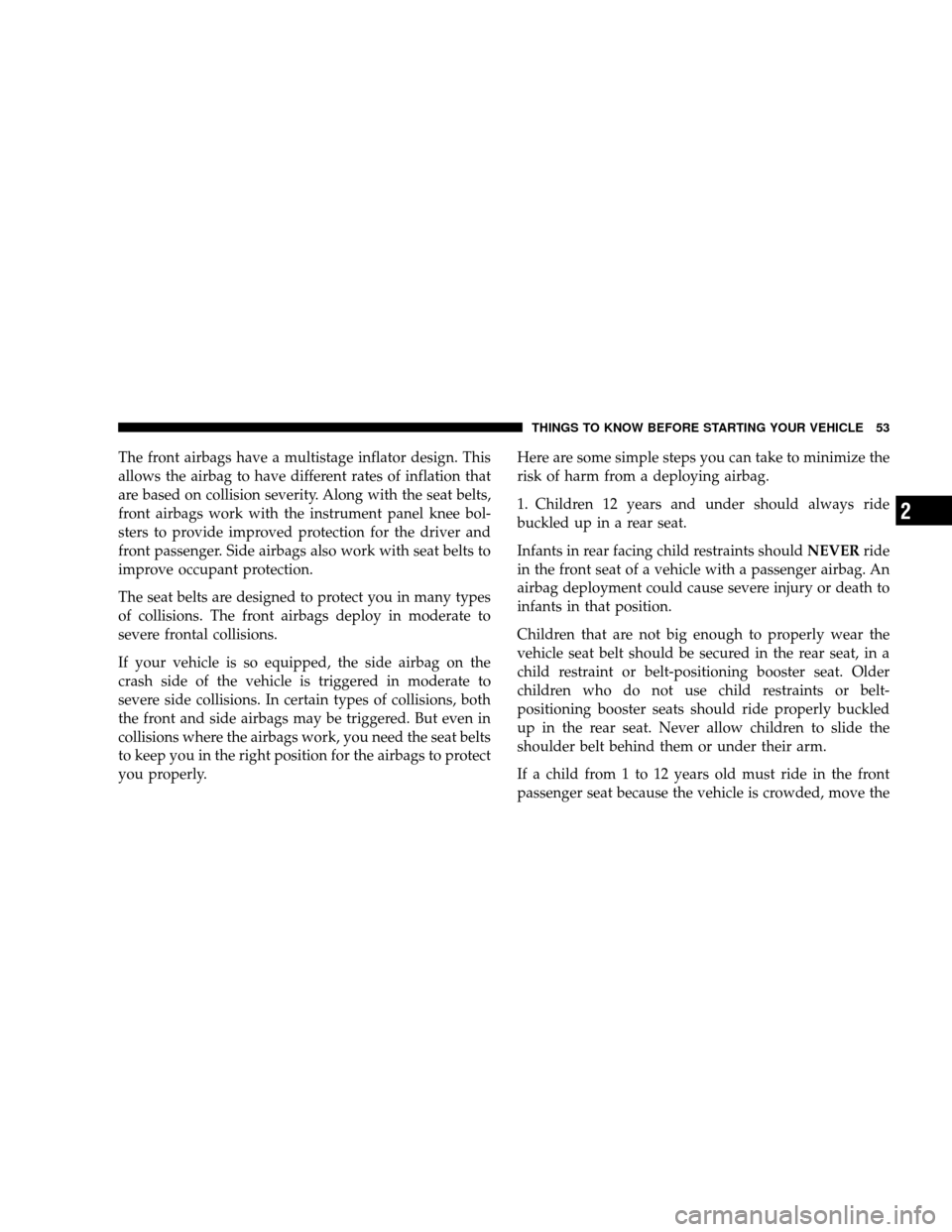Page 30 of 466
3. Unhook the door strap from the body hook. Be careful
not to allow the door to swing fully open as the mirror
may damage paint.
4. With the door open, lift the door to clear hinge pins
from their hinges, and remove door.
To reinstall the door(s), perform the previous steps in the
opposite order.Rear Door Removal (Four-Door Models)
1. Remove the hinge pin screws from the upper and
lower outside hinges (using a #T50 Torx�head driver).
2. Slide the front seat(s) fully forward.
THINGS TO KNOW BEFORE STARTING YOUR VEHICLE 29
2
Page 41 of 466

OCCUPANT RESTRAINTS
Some of the most important safety features in your
vehicle are the restraint systems. These include the front
and rear seat belts for the driver and all passengers, front
airbags for both the driver and front passenger, and side
airbags (if equipped) for both the driver and front
passenger. If you will be carrying children too small for
adult-size belts, your seat belts can also be used to hold
infant and child restraint systems.
NOTE:The front airbags have a multistage inflator
design. This allows the airbag to have different rates of
inflation that are based on collision severity.
Please pay close attention to the information in this
section. It tells you how to use your restraint system
properly to keep you and your passengers as safe as
possible.WARNING!
In a collision, you and your passengers can suffer
injuries, including fatalities, if you are not properly
buckled up. You can strike the interior of your
vehicle or other passengers, or you can be thrown out
of the vehicle. Always be sure you and others in your
vehicle are buckled up properly.
Buckle up even though you are an excellent driver, even
on short trips. Someone on the road may be a poor driver
and cause a collision that includes you. This can happen
far away from home or on your own street.
40 THINGS TO KNOW BEFORE STARTING YOUR VEHICLE
Page 43 of 466

WARNING!
•Wearing a seat belt incorrectly is dangerous. Seat
belts are designed to go around the large bones of
your body. These are the strongest parts of your
body and take the forces of a collision the best.
Wearing your belt in the wrong place could make
your injuries in a collision much worse. You might
suffer internal injuries, or you could even slide out
of part of the belt. Follow these instructions to
wear your seat belt safely and to keep your pas-
sengers safe, too.
•Two people should never be belted into a single
seat belt. People belted together can crash into one
another in an accident, hurting one another badly.
Never use a lap/shoulder belt or a lap belt for more
than one person, no matter what their size.
Lap/Shoulder Belt Operating Instructions
1. Enter the vehicle and close the door. Sit back and
adjust the seat.
2. The seat belt latch plate is above the back of the front
seat, next to your arm in the rear seat. Grasp the latch
plate and pull out the belt. Slide the latch plate up the
webbing as far as necessary to allow the belt to go around
your lap.
42 THINGS TO KNOW BEFORE STARTING YOUR VEHICLE
Page 47 of 466

6. To release the belt, push the red button on the buckle.
The belt will automatically retract to its stowed position.
If necessary, slide the latch plate down the webbing to
allow the belt to retract fully.
WARNING!
A frayed or torn belt could rip apart in a collision and
leave you with no protection. Inspect the belt system
periodically, checking for cuts, frays, or loose parts.
Damaged parts must be replaced immediately. Do
not disassemble or modify the system. Seat belt
assemblies must be replaced after a collision if they
have been damaged (bent retractor, torn webbing,
etc.).
Rear Center Lap/Shoulder Belt Retractor
Lock-Out (Four-Door Models Only)
This feature is designed to lock the retractor whenever
the 60% rear seatback is not fully latched. This prevents
someone from wearing the rear center lap/shoulder belt
when the rear seatback is not fully latched.
NOTE:
•If the rear center lap/shoulder belt cannot be pulled
out, check that the rear seatback is fully latched.
•If the rear seatback is properly latched and the rear
center lap/shoulder belt still cannot be pulled out, the
Automatic-Locking Retractor (ALR) system may be
activated. To reset this feature you must let all of the
belt webbing return into the retractor. You will not be
able to pull out more webbing until all of the webbing
has been returned back into the retractor.
46 THINGS TO KNOW BEFORE STARTING YOUR VEHICLE
Page 48 of 466
WARNING!
The rear center lap/shoulder belt is equipped with a
lock-out feature to ensure that the rear seatback is in
the fully upright and locked position when occupied.
If the rear seatback is not fully upright and locked
and the rear center lap/shoulder belt can be pulled
out of the retractor, the vehicle should immediately
be taken to your authorized dealer for service. Failure
to follow this warning could result in serious or fatal
injury.
Adjustable Upper Shoulder Belt Anchorage
In the front seat positions, the shoulder belt anchorage
can be adjusted upward or downward to position the belt
away from your neck. Push in on the anchorage near
your outside shoulder and slide it up or down to reach
the position that serves you best.
Adjusting Upper Shoulder Belt
THINGS TO KNOW BEFORE STARTING YOUR VEHICLE 47
2
Page 54 of 466

The front airbags have a multistage inflator design. This
allows the airbag to have different rates of inflation that
are based on collision severity. Along with the seat belts,
front airbags work with the instrument panel knee bol-
sters to provide improved protection for the driver and
front passenger. Side airbags also work with seat belts to
improve occupant protection.
The seat belts are designed to protect you in many types
of collisions. The front airbags deploy in moderate to
severe frontal collisions.
If your vehicle is so equipped, the side airbag on the
crash side of the vehicle is triggered in moderate to
severe side collisions. In certain types of collisions, both
the front and side airbags may be triggered. But even in
collisions where the airbags work, you need the seat belts
to keep you in the right position for the airbags to protect
you properly.Here are some simple steps you can take to minimize the
risk of harm from a deploying airbag.
1. Children 12 years and under should always ride
buckled up in a rear seat.
Infants in rear facing child restraints should
NEVERride
in the front seat of a vehicle with a passenger airbag. An
airbag deployment could cause severe injury or death to
infants in that position.
Children that are not big enough to properly wear the
vehicle seat belt should be secured in the rear seat, in a
child restraint or belt-positioning booster seat. Older
children who do not use child restraints or belt-
positioning booster seats should ride properly buckled
up in the rear seat. Never allow children to slide the
shoulder belt behind them or under their arm.
If a child from 1 to 12 years old must ride in the front
passenger seat because the vehicle is crowded, move the
THINGS TO KNOW BEFORE STARTING YOUR VEHICLE 53
2
Page 63 of 466

•Airbag deployment level (if applicable)
•Impact acceleration and angle
•Seat belt status
•Brake status (service and parking brakes)
•Accelerator status (including vehicle speed)
•Engine control status (including engine speed)
•Transmission gear selection
•Cruise control status
•Traction/stability control status
•Tire pressure monitoring system (TPMS) status
Child Restraint
Everyone in your vehicle needs to be buckled up at all
times — babies and children, too. Every state in the
United States and all Canadian provinces require that
small children ride in proper restraint systems. This is the
law, and you can be prosecuted for ignoring it.
Children 12 years and under should ride properly buck-
led up in a rear seat, if available. According to crash
statistics, children are safer when properly restrained in
the rear seats, rather than in the front.
There are different sizes and types of restraints for
children from newborn size to the child almost large
enough for an adult safety belt. Always check the child
seat owner’s manual to ensure you have the correct seat
for your child. Use the restraint that is correct for your
child.
62 THINGS TO KNOW BEFORE STARTING YOUR VEHICLE
Page 64 of 466

WARNING!
In a collision, an unrestrained child, even a tiny baby,
can become a missile inside the vehicle. The force
required to hold even an infant on your lap could
become so great that you could not hold the child, no
matter how strong you are. The child and others
could be badly injured. Any child riding in your
vehicle should be in a proper restraint for the child’s
size.
Infants and Child Restraints
•
Safety experts recommend that children ride
rearward-facing in the vehicle until they are at least
one-year oldandweigh at least 20 lbs (9 kg). Two
types of child restraints can be used rearward-facing:
infant carriers and “convertible” child seats.
•The infant carrier is only used rearward-facing in the
vehicle. It is recommended for children who weigh up
to about 20 lbs (9 kg). “Convertible” child seats often
have a higher weight limit in the rearward-facing
direction than infant carriers do, so they can be used
rearward-facing by children who weigh more than 20
lbs (9 kg) but are less than one year old. Both types of
child restraints are held in the vehicle by the lap/
shoulder belt or the LATCH child restraint anchorage
system (Refer to LATCH — Child Seat Anchorage
System in this section.)
•Rearward-facing child seats must NEVERbe used in
the front seat of a vehicle with the front passenger
airbag unless the airbag is turned off. An airbag
deployment could cause severe injury or death to
infants in this position.
THINGS TO KNOW BEFORE STARTING YOUR VEHICLE 63
2